 Chris Hamilton
.
August 19, 2020
.
Editor
Chris Hamilton
.
August 19, 2020
.
Editor
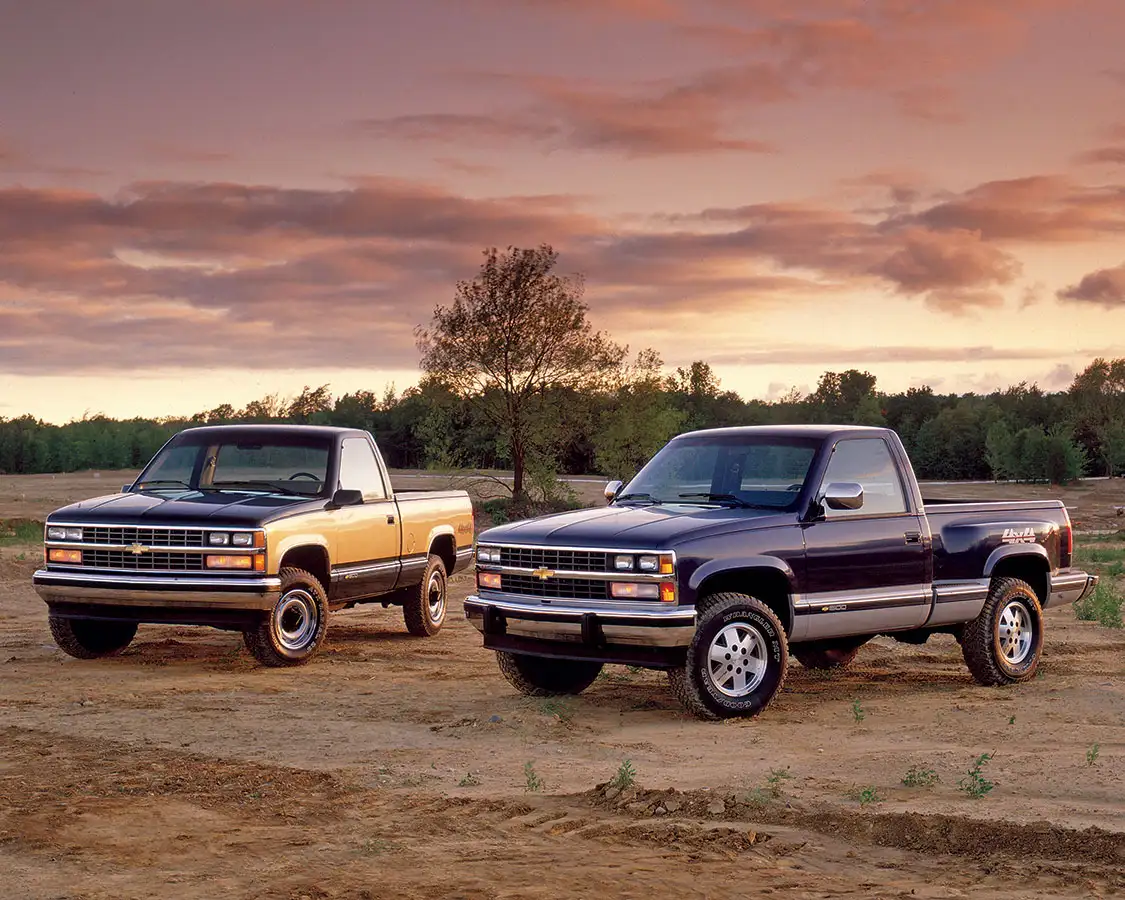
OBS refers to Chevy C/K trucks that were manufactured by General Motors between the years 1988 and 1998. Marketed under the Chevrolet and GMC brands, the C/K series included a wide range of vehicles including a truck and two SUV models. While most commonly associated with pickup trucks, the model line also included medium-duty and heavy-duty trucks. The “C” denoted a two-wheel drive; “K” denoted four-wheel drive.
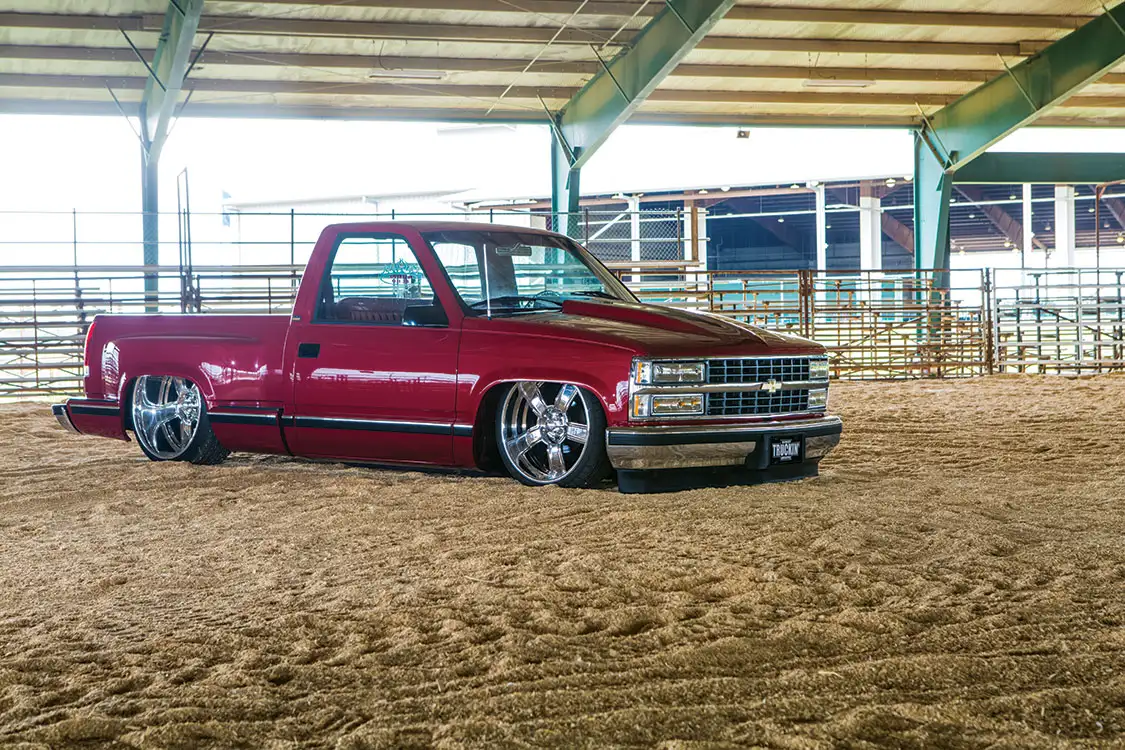
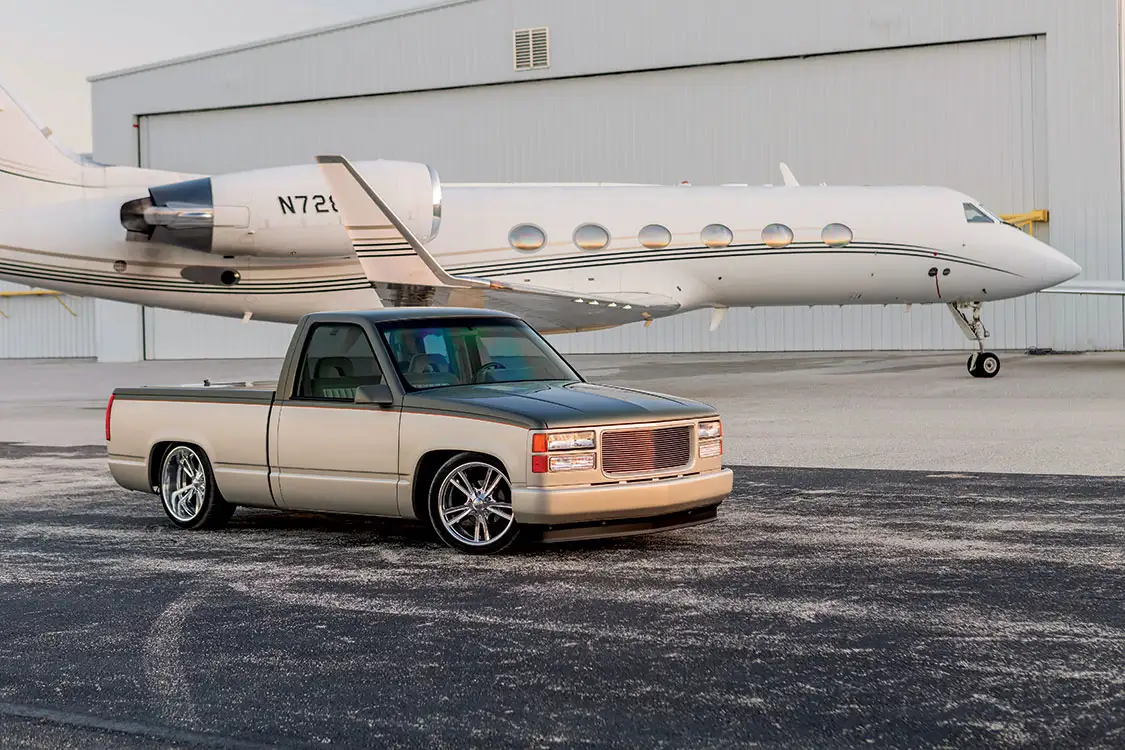
General Motors released eight different versions of the C/K line for 1988: Fleetside Single Cab, Fleetside Extended Cab, Fleetside Crew Cab and Stepside Single Cab models, each in either 2WD or 4WD drivelines. Three trim levels were available for these trucks, including Cheyenne, Scottsdale and Silverado.
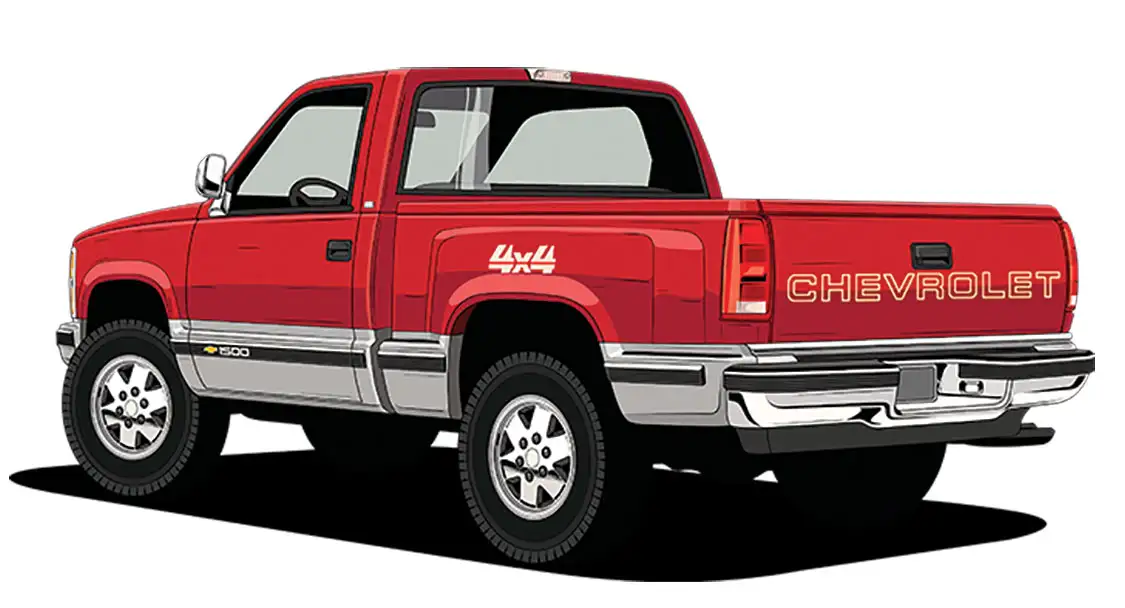
GMT400/480 ’88–’00 Chevrolet C/K – GMC Sierra
GMT410 ’92–’99 Chevrolet Suburban
GMT415 ’92–’94 Chevrolet Full-Size Blazer
GMT420 ’95–’00 Chevrolet Tahoe
GMT425 ’92–’99 GMC Suburban
GMT430 ’92–’00 GMC Yukon
In 1989, a Sport Equipment Package was available on either C/K 1500 Fleetside shortbed single cab model. The package featured a black grille with red outlined bow-tie emblem, black moldings outlined in red, body color front and rear bumpers, black mirrors and “SPORT” identification decals on the box and on the tailgate. There were no suspension or engine upgrades provided with any of the sport packages as this was an appearance only option.
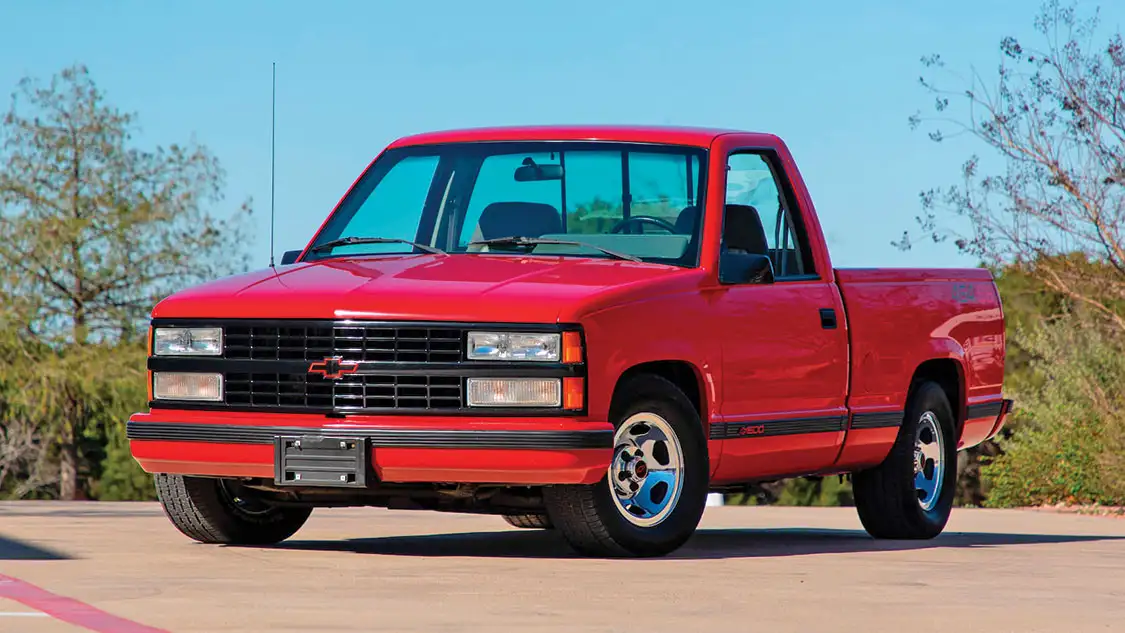
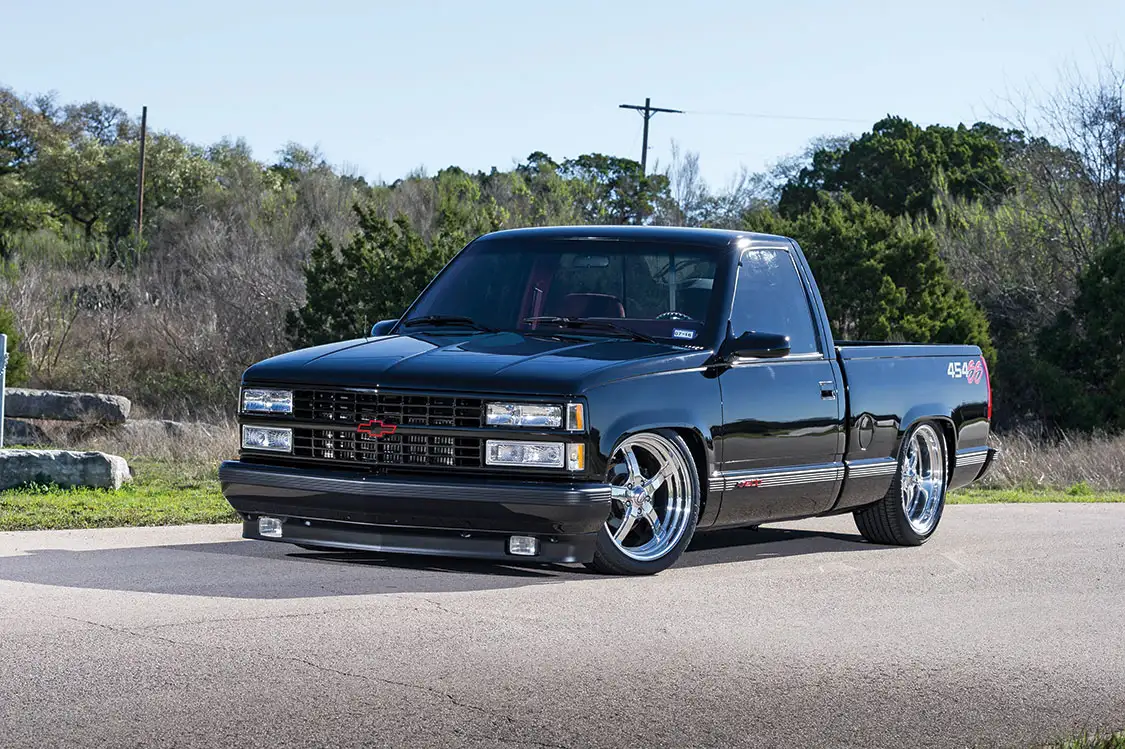



Throttle body (TBI) fuel injection was used on ’88-’95 gas engines.
Central point injection (CPI) was used on the ’96-’00 4.3L V-6, 5.0L V-8 and 5.7L V-8.
The Work Truck (W/T) was introduced in 1988, which featured a single cab longbed with Cheyenne trim and a new grille with black bumpers.
In 1990, Chevrolet introduced a high-performance variant of the GMT400 under the Super Sport emblem called the 454 SS. It was available only as a 2WD half-ton regular cab short box in Onyx Black with a garnet red interior. Unique exterior features included a front air dam with fog lights, special rims, decals displaying “454 SS” on the bed sides, red trim emblems, and black painted grille, bumpers and mirrors.
The MSRP of the 1990 model was $18,295. A total of 16,953 units were sold over the four years the 454 SS was in production; 13,748 units were sold in 1990 alone.
The 454 SS was powered by a 454ci (7.4L) V-8 producing 230hp. A Turbo Hydra-Matic 400, 3-speed automatic transmission and 3.73 rear axle ratio added to the truck’s performance. The axle itself is unique, being a 14-bolt semi-floating unit that uses standard Chevrolet 5 on 5-inch wheels—the only factory-produced 14-bolt axle with such a wheel bolt pattern.
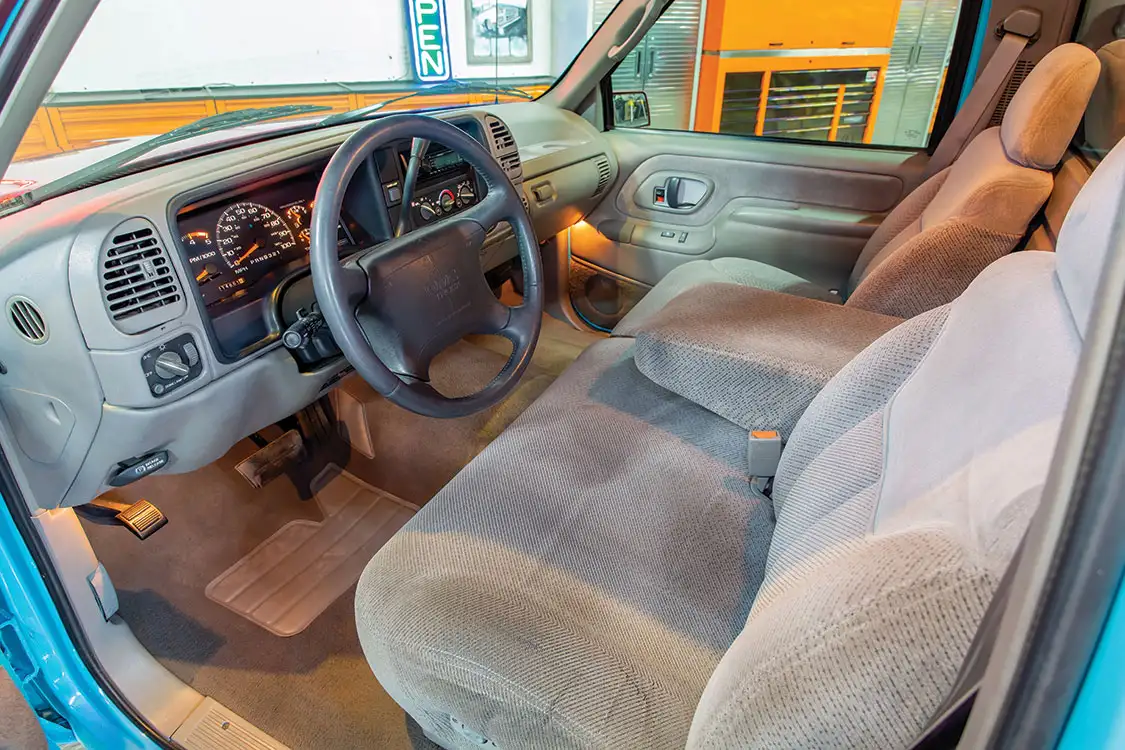
In 1991, the 4L80-E automatic transmission was added for three-quarter and one-ton trucks.
In 1991, California introduced a standard called OBD-I in order to curb vehicle emissions. All cars had to be equipped with a system that could detect engine issues and report trouble codes. Unlike the later OBD-II standard, however, OBD-I wasn’t standardized across manufacturers.
This means that an OBD-I scan tool will often work for only one make of car. In addition, the codes themselves aren’t standardized, so a Ford with the same engine issue as a Toyota might give a totally different trouble code.
In 1993 General Motors re-introduced the Sport branded trucks along with the 454 SS. The 454 SS was discontinued after the 1994 model year.

In 1993, the 700-R4/4L60 transmission was revised with electronic controls, becoming the 4L60-E.
The 1994 models received a new front fascia, federally mandated center high-mount stop lamp, many new exterior colors including a new two-tone option on the rocker panels, and new tire and wheel combinations.
All 1995 models received a new interior that included a new steering wheel with the 1500s containing a driver’s-side airbag, a new dashboard containing a more centrally mounted radio, dial-operated HVAC system, and an improved gauge cluster. New front door panels and new seats were also included.

In 1996, OBD-II became a nationwide standard and it has been used ever since. Unlike OBD-I, OBD-II equipped cars all support the same type of scanner. The trouble codes themselves have also been standardized across all manufacturers.
For 1996, a passenger-side-mounted third door became optional on extended cab models.
C/K 1500 models received a passenger-side airbag for 1997 to comply with new federal regulations for light trucks.

1997 was to be the last year the C/K Silverado would display “CHEVROLET” on the tailgate.
In 1999, the Chevrolet Silverado became the divisional replacement for the C/K.
The Chevrolet Tahoe is a full-size SUV from General Motors. Chevrolet and GMC sold two different-sized SUVs under their Blazer/Jimmy model names through the early 1990s. This situation changed when GMC rebadged the full-size Jimmy as the Yukon in 1991. All were two-door models through 1994.

The Chevrolet K5 Blazer name was discontinued after the 1994 model year, and the Chevrolet Tahoe was introduced in 1995 with the addition of an all-new four-door version.
The Tahoe has regularly been the bestselling full-size SUV in the United States, frequently outselling its competition by 2 to 1.

Both two-door and four-door models were produced in rear- and four-wheel drive. The two-door weighs roughly 4,500 pounds while the four-door weighs approximately 5,500 pounds. The two-door has a 6-inch shorter wheelbase than the four-door.
The standard engine was Chevrolet’s 5.7L (350ci) small-block V-8, while a turbocharged 6.5L (395ci) Detroit Diesel V-8 was available beginning in 1994.
The GMT400-based Suburbans were introduced in December 1991 for the 1992 model year even though the similar pickup truck models had switched to the newer platforms in the 1988. Both 2WD and 4WD models, designated “C” and “K”, were offered, as well as half ton and three-quarter ton versions.
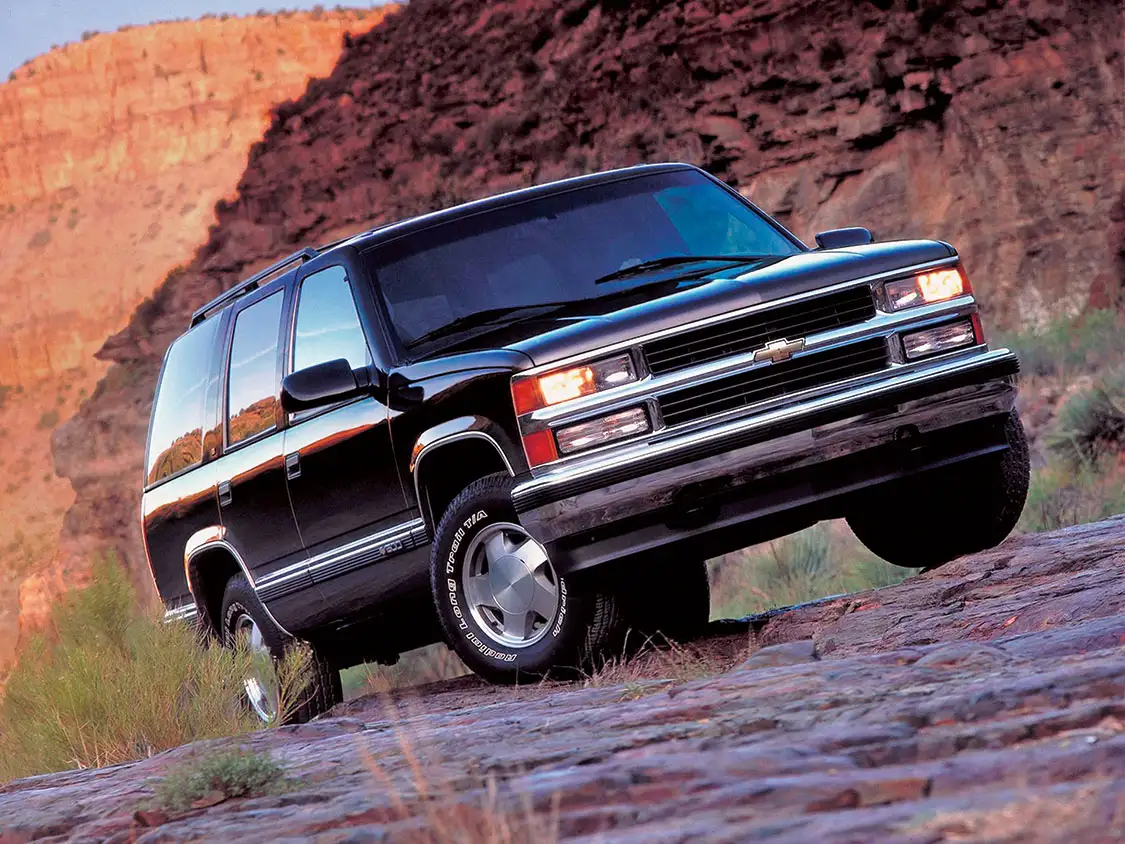
The GMT400 series introduced independent front suspension. The 2WD models used coil springs and 4WD models used torsion bars in the front suspension. All models used a live axle and leaf springs in the rear.
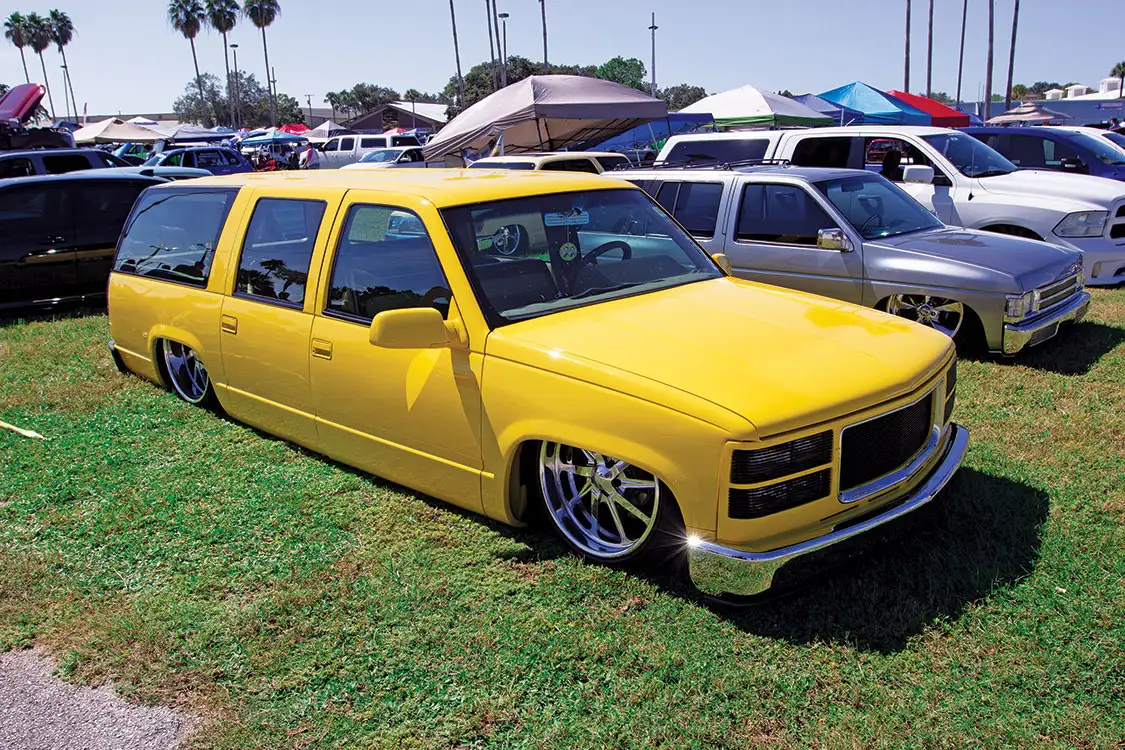
For a 1995 Suburban, 0–60 mph times were around 9.3 seconds at best. The top speed of a 1995 Suburban was governed on the engine for economy and a maximum of 98 mph could be obtained with a fuel economy of 13 mpg.
If you’re looking to upgrade your OBS GMT400 truck, there are several reputable sources that offer a wide range of aftermarket and performance parts. Here’s a breakdown of some of the best:
For those interested in upgrading their transmission systems, American Powertrain provides a variety of high-performance transmission solutions.
Looking for custom and performance enhancements? Elevated Concepts, Inc. specializes in aftermarket solutions that can take your truck to the next level.
Renowned for their expertly crafted transmissions, Gearstar serves the needs of performance enthusiasts who demand reliability and superior engineering.
From body parts to complete restoration kits, LMC Truck offers a comprehensive selection of components tailored specifically to OBS GMT400 trucks.
For those who want to boost their truck’s performance, Pro Performance provides a variety of parts, from suspensions to brakes, that meet the highest standards of quality.
If performance tuning and specialized suspension components are what you’re after, QA1 offers a range of products to enhance your truck’s handling and comfort.
To completely transform your truck’s ride quality, check out Ridetech for advanced suspension systems and air ride solutions.
A one-stop-shop for virtually any aftermarket or replacement part you might need, Rock Auto offers a vast inventory from multiple brands, ensuring you find the right fit for your GMT400.
By exploring these trusted sources, you’ll secure top-tier aftermarket and performance parts to elevate your GMT400 truck’s capabilities.
From its launch, the GMT400 platform has captivated enthusiasts, gaining immediate traction in the customization scene. Early modifiers, including renowned builders, quickly saw its potential and began to innovate.
This platform didn’t just flash and fade; its appeal has remained constant over the years. What’s particularly fascinating, however, is the surge in recent attention. Over the past two years, there’s been an impressive uptick in both the volume and quality of aftermarket performance parts available.
With the expanding array of aftermarket options, the possibilities for the GMT400 seem limitless, promising exciting developments in the near future.
If you’re considering switching to a manual transmission for performance purposes in your GMT400 truck, opting for a specialized car transmission can be a more effective choice over the standard New Venture units.
When upgrading, you typically need more than just the transmission itself. Comprehensive kits are available that include:
These kits often provide all the necessary parts to ensure a smooth and hassle-free installation. Additionally, sourcing a clutch pedal can be challenging but is essential for the proper functionality of your manual setup.
Switching to one of these high-performance car transmissions will significantly enhance your GMT400 truck’s driving experience. Whether you go with the TKO five-speed for balanced performance or the T56 Magnum six-speed for ultimate power handling, these options will undoubtedly elevate your vehicle’s capabilities.
Upgrading engine performance in states with stringent emissions laws like California can be quite challenging. Here’s why:
Engines from the throttle body injected (TBI) era and the 1996-and-later Vortec 350 face particularly tough restrictions. The market offers fewer compliant parts for these older systems, making performance upgrades more complicated and often more expensive.
States with strict emissions regulations enforce rigorous visual and rolling tailpipe tests. This means that any modifications must meet specific standards. While parts like CARB-compliant cylinder heads, camshafts, and headers are available, they must be correctly installed and tuned to pass these tests.
Tuning engines with OBD-1 and early OBD-II systems is especially tricky. These older models often require new PROM chips to be burned and installed into the engine control unit (ECU) or powertrain control module (PCM). This adds an extra layer of complexity and cost.
Despite the challenges, there are solutions available. Flash-programmable EEPROM conversions and tuning software for OBD-1 computers can simplify the process, but they require specialized knowledge and tools. Websites like Moates.net and GearheadEFI offer valuable resources for those navigating these upgrades.
Upgrading your engine in a state with tough emissions laws isn’t impossible, but it demands careful planning, specialized components, and sometimes, expert assistance.
If you’re looking to enhance the suspension of your GMT400 truck, there are several options available that go beyond the standard drop spindle and axle flip lowering kits.
Front and rear coilover conversion kits offer an advanced alternative. These kits not only lower your truck but also significantly improve handling and ride quality. For instance, some companies utilize unique rear upper A-arms to position the axle housing, while others prefer a torque arm and Panhard bar setup for the rear suspension.
Upgrading to tubular front A-arms can make a noticeable difference. These components are often paired with larger sway bars to provide a more stable and controlled ride. Additionally, adjustable shocks allow for fine-tuning the suspension to suit different driving conditions and preferences.
For those looking for a more customized approach, there are specialized companies that focus solely on suspension and frame stiffening systems. These niche solutions often include enhancements like rack and pinion steering systems, specifically designed for the GMT400 platform, delivering a unique driving experience.
No matter which suspension upgrade you choose, a combination of lowering, quality shocks, and high-performance tires will dramatically improve both the look and handling of your GMT400 truck.
The GMT400 platform has become increasingly popular for enthusiasts looking to enhance their truck’s performance. In recent years, we’ve seen a surge in the variety and quality of aftermarket parts designed for these trucks. Here’s a detailed look at some of the top performance upgrades you can consider for your GMT400:
The evolution of aftermarket performance parts for GMT400 trucks is fascinating. From improving overall power to fine-tuning handling and braking, the options are vast and continually expanding.
With the right upgrades, your GMT400 can achieve remarkable gains in performance, making it a beast both on-road and off-road.
Dealing with rust issues on OBS GMT400 trucks? There’s an array of aftermarket solutions available to restore these classic vehicles to their former glory.
For starters, you can replace rusted components with brand-new sheet metal sourced from various restoration companies and truck specialists. Options include:
What’s great is that these components are often surprisingly affordable, making it feasible to maintain your truck’s condition without breaking the bank.
Using aftermarket parts allows for high customization and ensures compatibility with your specific truck model. These parts can often be more accessible and cost-effective than original manufacturer parts.
By investing in quality aftermarket parts, you’ll not only address rust issues but also enhance the overall aesthetic and functionality of your GMT400 truck.
The brakes on GMT400 trucks have garnered criticism for several reasons, particularly from those who require reliable stopping power for towing, hauling, or spirited driving.
The front brakes come with relatively small 11-inch or 11.25-inch rotors paired with single-piston calipers. The rear brakes aren’t much better, offering 10-inch or 11-inch drums. This size limitation means they quickly become inadequate under heavy load or intense driving conditions.
For tasks like towing or hauling, the standard braking system simply can’t keep up. Drivers often find themselves wishing for larger, more capable brakes, especially in situations where quick and reliable stopping is crucial.
Adding to the frustration, the Quick Take Up brake master cylinder combined with low-drag brake calipers results in a brake pedal feel that many describe as “mushy.” The long pedal travel distance can be disconcerting, giving drivers less confidence in the vehicle’s braking capabilities.
Given these points, it’s clear why the stock braking system on GMT400 trucks leaves much to be desired. For those requiring more robust performance, upgrading to larger, more efficient brakes is often considered a necessary improvement.
The GMT400 series of trucks, produced during the late ’80s and ’90s, often face challenges related to their clear coat. These vehicles are particularly prone to oxidation, a process where the clear coat deteriorates due to prolonged exposure to the sun. Over time, this exposure can lead to visible wear and damage.
Here are key issues you might encounter:
To mitigate these problems, regular maintenance and specific treatments can help:
Keeping these points in mind will help maintain the appearance and longevity of your GMT400 truck’s clear coat.
The GMT400 series introduced several groundbreaking changes that set it apart from earlier models.
First and foremost, the GMT400 series was the debut lineup to feature independent front suspension on its 4×4 models. This advanced design replaced the older solid front axle and leaf springs with torsion bars and CV joints.
These modifications not only improved the driving experience but also significantly boosted the safety and convenience of the GMT400 series, marking a notable evolution from its predecessors.
In 1991, the 4L80-E automatic transmission was added for three-quarter and one-ton trucks.
In 1993, the 700-R4/4L60 transmission was revised with electronic controls, becoming the 4L60-E.
For those considering manual transmission upgrades, several options were available during the production of GMT400 trucks. The half-ton pickups typically came with HM290/5LM60 or NV3550 five-speed transmissions, generally rated to handle around 300 lb-ft of torque. Meanwhile, the more robust NV4500 was an option for the 2500 and 3500 series trucks. These transmissions were designed specifically for these trucks, featuring a steeper first gear and larger RPM drops between shifts.
If you’re looking to enhance performance by switching from an automatic to a manual transmission, opting for a “car” transmission might be more beneficial. Kits are available that offer TKO five-speed or T56 Magnum six-speed options, depending on your power requirements. These kits often include the necessary flywheel, clutch assembly, and hydraulic components, and can assist in sourcing a clutch pedal, which can be hard to find.
These smoother-shifting transmissions can significantly transform your truck’s driving experience, providing a more engaging and responsive feel behind the wheel.
What is OBS Trucks? (Old Body Style or Original Body Style)
OBS refers to Chevy C/K trucks that were manufactured by General Motors between the years 1988 and 1998. Marketed under the Chevrolet and GMC brands, the C/K series included a wide range of vehicles, including a truck and two SUV models. While most commonly associated with pickup trucks, the model line also included medium-duty and heavy-duty trucks. The “C” denoted a two-wheel drive; “K” denoted four-wheel drive.
The OBS label was assigned to the GMT400 once the GMT800 (model years 1999-2006) were introduced, and that generation is known as NBS, or ‘new body style.’ In SUV form (Tahoe, Yukon, and Suburban), the GMT400 continued through the 2000 model year and even into 2002 for the one-ton C3500 pickups.
Outwardly, the GMT400 represented a significant visual departure from the square body trucks it replaced, featuring a sleek, aerodynamic body. More noteworthy changes, however, could be found underneath. This was the first GM pickup to feature an independent front suspension on their 4×4 models, utilizing torsion bars and CV joints to replace the solid front axle and leaf springs of the previous generation.
These trucks are not just cherished for their nostalgic value but also for the practical and innovative improvements they introduced. The combination of visual appeal and mechanical advancements makes them highly sought after by both collectors and enthusiasts. Whether for restoration projects or daily use, the OBS Chevys offer a blend of classic design and forward-thinking engineering.
When you’re looking to enhance the visual appeal of a lifted OBS (Old Body Style) truck, adding oversized all-terrain tires is a game-changer. These robust tires do more than just fill out the wheel wells; they transform the entire presence of your vehicle.
Installing oversized all-terrain tires is a strategic way to boost both the performance and appearance of a lifted OBS truck, instantly elevating its presence from ordinary to extraordinary.
When it comes to modifying the headlights and taillights of older body style (OBS) trucks, enthusiasts often opt for enhancements that blend style with functionality. Here are some popular modifications:
Pair these lighting enhancements with additions like a custom chrome grille to accentuate your truck’s revamped style and make it truly stand out on the road.
A custom paint job can breathe new life into an OBS truck, elevating its aesthetic appeal far beyond its aging, original coat. Here’s how a fresh paint job can make a difference:
With these modifications, your OBS truck can become a head-turner, showcasing both traditional roots and modern style.
Chrome-plated exhaust tips have become nearly synonymous with OBS (Old Body Style) trucks, particularly those customized beyond their original stock builds. But why do these shiny accessories seem like an essential touch for truck enthusiasts?
The primary reason is aesthetics. Chrome tips offer a polished, high-end look that significantly enhances the visual appeal of any vehicle. They give an impression of both power and prestige, making these trucks stand out on the road.
Though often primarily cosmetic, chrome exhaust tips are frequently part of broader exhaust system upgrades. Enthusiasts often replace entire exhaust systems to boost performance metrics such as horsepower and torque. With such enhancements, the sound emitted from the vehicle becomes deeper and more resonant, aptly complemented by the striking appearance of chrome-plated tips.
Chrome-plating also provides a layer of protection against rust and corrosion. This durability ensures that the exhaust tips maintain their brilliance over time, even under harsh weather conditions. Easy to clean and maintain, they remain a favorite for those who want their trucks to look pristine with minimal effort.
Lastly, upgrading to chrome exhaust tips allows owners to express individuality. It’s a canvas for customization, whether sticking with classic designs or opting for more unique, personalized shapes.
In summary, chrome-plated exhaust tips are considered essential for OBS trucks because they enhance appearance, improve performance aspects, offer resilience, and allow for personal expression. These benefits make them a staple choice for truck enthusiasts aiming to combine style with substance.
Window tinting serves multiple purposes when modifying OBS (Old Body Style) trucks, beyond just aesthetic appeal. Here’s a detailed look at why enthusiasts choose to tint their truck windows:
Incorporating window tint into your OBS truck modification not only enhances its style but also delivers functional benefits that amplify both comfort and safety.
Since acquiring in July 2017, a myriad of maintenance and modifications have been undertaken to keep it in top shape and enhance its performance. Here’s a detailed breakdown of the work done:
Enhancing the ride dynamics, a Ridetech 4/6 suspension drop kit paired with single adjustable shocks was installed to lower the vehicle. This modification not only improves handling but gives the truck a sleek, aggressive stance.
Rebuilt door hinges, added new weather-stripping, and replaced damaged lock rod and door handle clips. These enhancements improve both functionality and aesthetics, ensuring the doors operate smoothly and complement the truck’s new look.
A custom paint job can dramatically transform the truck’s appearance. Options range from restoring the original color to opting for a high-gloss or matte finish. Such changes can breathe new life into the vehicle, making it stand out on the road.
New headlights and taillights, especially those utilizing LED technology, offer improved visibility and a modern touch. This modification, combined with a custom grille, creates a striking front-end appearance.
Chrome-plated exhaust tips are considered essential for many enthusiasts, and a complete exhaust overhaul can enhance both power and sound, adding to the truck’s character and performance.
Custom seat upholstery and updated dashboard elements allow owners to personalize their truck’s interior. While some prefer original or refurbished conditions, these changes can make the space uniquely theirs.
Installing oversized all-terrain tires on standard-sized wheels is a popular choice for those looking to enhance the rugged look of a lifted OBS truck. This gives the vehicle an imposing presence and complements the raised suspension.
OBS (Old Body Style) trucks are celebrated for their robust design and enduring appeal. Their durability primarily stems from a few key features that highlight their ruggedness.
In essence, the rugged durability of OBS trucks lies in their combination of strong structural design, versatile off-road performance, and commendable load capacities. These attributes ensure they stand the test of time while remaining functional and eye-catching.
Older Body Style (OBS) trucks, primarily those manufactured in the early 1990s, often fall short when it comes to contemporary safety features that modern drivers have come to expect. Let’s dive into what’s typically missing:
If safety is a priority, retrofitting some of these features on older models can elevate safety levels significantly. However, comprehensive installation might be cost-prohibitive, and it’s crucial to weigh the benefits against potential expenses.
When it comes to older body style (OBS) trucks, one of the most common concerns is the quality of their interior materials. These trucks, which gained popularity in the 1990s, often incorporated significant amounts of plastic inside the cabin. While this may have been fashionable at the time, it presents several challenges today.
Today’s automotive industry uses a wide range of materials for interiors, enhancing not only the look but also the durability and safety of vehicles. Drivers considering upgrades or replacements may benefit from these newer materials, which can reduce the long-term issues associated with the older plastic interiors of OBS trucks.
By acknowledging these interior challenges and exploring modern solutions, OBS truck owners can preserve the nostalgic aesthetic of their vehicles while embracing advancements in automotive technology.
These trucks are not just cherished for their nostalgic value but also for the practical and innovative improvements they introduced. The combination of visual appeal and mechanical advancements makes them highly sought after by both collectors and enthusiasts. Whether for restoration projects or daily use, the OBS Chevys offer a blend of classic design and forward-thinking engineering.
The fourth-generation C/K platform, known as GMT400, laid the groundwork for some of the most beloved OBS models. This robust platform was the backbone for a range of vehicles, including:
These models shared a design that defined an era, bringing a unique mix of functionality and style that continues to attract attention today. While Chevrolet used the C/K nomenclature, GMC opted for the Sierra name for its full-size pickups, each contributing to the platform’s versatility.
One of the standout features of OBS trucks is their distinct and classic style. The box-like design, once a trend of the past, now holds a nostalgic charm that appeals to both older enthusiasts and younger drivers. This unique aesthetic sets these trucks apart from the sleek and modern designs of today, making them a favorite for those looking to stand out.
OBS trucks are renowned for their customizability. Their older design allows for easier modifications, with many parts being straightforward to replace or upgrade. The aftermarket industry thrives on providing diverse options, from decals to body parts, making it simple to tailor these trucks to personal tastes. This ease of customization adds a layer of appeal for hobbyists who enjoy creating something truly unique.
The rugged construction of OBS trucks is another factor in their popularity. They are built to last, with strong off-road capabilities that don’t compromise urban drivability. Even if they don’t match the power of modern trucks, their high payload and towing capacities remain impressive. This durability makes them a practical choice for many enthusiasts.
Originally crafted as full-size pickup trucks and chassis cabs, the GMT400 platform expanded into the realm of full-size SUVs, demonstrating its adaptability. This evolution was key to its lasting popularity as it managed to capture the spirit of the times while offering something uniquely timeless.
When the GMT800 platform succeeded the GMT400, it didn’t quite capture the hearts of enthusiasts, which only heightened the allure of the old-school OBS look. This enduring appeal underscores how the C/K platform’s blend of classic aesthetics and innovative engineering continues to captivate and inspire.
When it comes to customizing the interior of OBS (Old Body Style) trucks, enthusiasts have a variety of options to express their personal style and preferences. Here are some popular interior modifications:
While these customizations are common across the enthusiast community, a significant number of OBS truck owners prefer to keep their vehicles in original or refurbished condition. This approach respects the truck’s classic appeal while ensuring it maintains its authenticity and potential value.
Customizing OBS trucks goes beyond just the interior. The age of these vehicles opens up a world of possibilities for modifications, both a boon and a potential challenge. Due to their vintage nature, many parts might require replacement, but this also provides a blank canvas for personalization.
In summary, whether you’re seeking a modern edge or preserving a vintage look, there’s an array of customization possibilities for OBS trucks. The combination of available parts and ease of modification makes these vehicles a popular choice for those eager to inject personal flair into their ride.
When it comes to the GMT400 series trucks, owners often encounter a few recurring issues. Here’s a rundown of the most common problems:
Rust is a notorious issue for these trucks. Even though they were touted as having good corrosion protection, this claim was only valid when comparing them to their predecessors. Key areas prone to rust include:
This is especially true for trucks in wet and snowy climates, where moisture accelerates the rusting process.
The dashboard design saw a significant overhaul in 1995, which improved its durability. However, earlier models suffer from:
While the later dashboards offer better resistance, it’s a common point of concern for those with older models.
Interior materials vary in longevity. Generally:
This difference is important to consider if you value your truck’s interior condition.
Like many American vehicles from the ’80s and ’90s, the GMT400 series struggles with clear coat problems. Sun exposure tends to:
This typically results from manufacturers adapting to new paint emission regulations, which affected the durability of the paint.
The brake system is another common complaint. GMT400 trucks come with:
These brakes often prove insufficient for towing, hauling, or spirited driving. Issues include:
The system’s Quick Take-Up master cylinder and low-drag calipers sound good on paper but don’t always deliver the best performance.
Owning a GMT400 series truck means dealing with its vintage nature. The older technology of these vehicles doesn’t match the performance and efficiency of modern trucks. For example, older models lack the fuel efficiency of newer vehicles, which can lead to increased gas costs.
While the dashboards and upholstery present noticeable wear over time, the prevalence of plastic interiors in these trucks can also lead to a lower-quality appearance. The evolution of vehicle interior materials means that these older models might not meet the aesthetic or durability expectations of today’s drivers.
It’s important to note that trucks from this era often lack modern safety features like airbags, which were not mandated until the late 1990s. This absence can pose a significant risk, making it crucial for owners to consider investing in aftermarket safety upgrades.
Share Link